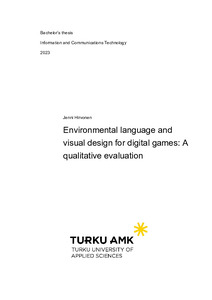Environmental language and visual design for digital games : a qualitative evaluation
Hirvonen, Jenni (2023)
Hirvonen, Jenni
2023
All rights reserved. This publication is copyrighted. You may download, display and print it for Your own personal use. Commercial use is prohibited.
Julkaisun pysyvä osoite on
https://urn.fi/URN:NBN:fi:amk-2023060217378
https://urn.fi/URN:NBN:fi:amk-2023060217378
Tiivistelmä
Peliympäristöt muodostavat yhden suurimmista visuaalisista komponenteista videopeleissä, ja interaktiivisuuteen yhdistettynä ne ovat voimakas tarinankerronnan väline. Interaktiivisuus johtaa kuitenkin myös narratiiviseen paradoksiin: miten käy hyvien tarinoiden, kun niihin liitetään pelaajan vapaus. Tämän opinnäytetyön aiheena oli tutkia, kuinka ympäristöllisellä kielellä ja visuaalisella suunnittelulla voidaan ohjata pelaajaa ilman, että vapauden tunne tai tarina kärsivät. Tätä varten luotiin aiemman kirjallisuuden sekä olemassa olevien pelien pohjalta designperiaatteet, jotka lisättiin valmiiseen videopelikenttään. Neljä testaajaa pelasi kentän läpi, minkä jälkeen heitä haastateltiin kokemuksestaan. Haastattelujen ja havainnoinnin perusteella valot, värit sekä liike ohjasivat hyvin pelaajia haluttuun suuntaan. Pelaajat nojasivat myös peliympäristön affordanssiin erityisesti silloin, kun pelikokemusta oli vähemmän. Jatkotutkimuksen avulla peleistä olisikin mahdollista tehdä paremmin saavutettavia sekä laajemmalle yleisölle että erilaisille pelaajatyypeille. Game environments are one of the significant visual components of a video game, and together with interactivity, video games become a powerful tool for storytelling. However, this combination also creates a narrative paradox: how can good stories be told, while granting the players freedom within the game? To address the paradox, this thesis investigates how indirect control methods such as environmental language and visual design can be used to guide the player while still allowing sufficient freedom within the game. To achieve this, a set of design principles was created based on present literature and examples from current video games. These design principles were applied to a level of an existing game and tested by four play testers, who were instructed to play the level from start to finish. The playthroughs were observed, and afterward, the play testers were interviewed. They were asked to share their experiences in their own words, after which more specific questions on the environmental language and visual design were asked. The results showed that lights, colour, and movement were powerful visual design tools. Testers gravitated towards them and were able to find important objects from the game environment. Players also relied heavily on affordance, which had both positive and negative effects on guiding them. Players with different levels of gaming experience seemed to use affordance differently. Further studies could help to make games more accessible for broader audiences, as well as diverse types of players.
